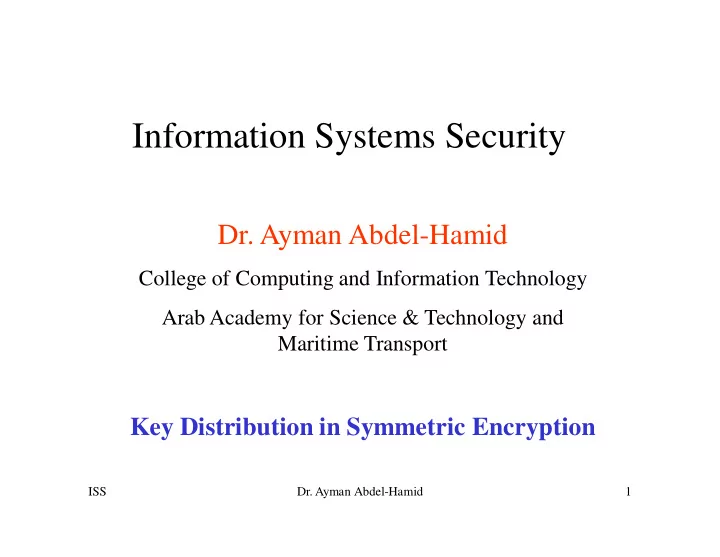

Information Systems Security Dr. Ayman Abdel-Hamid College of Computing and Information Technology Arab Academy for Science & Technology and Maritime Transport Key Distribution in Symmetric Encryption ISS Dr. Ayman Abdel-Hamid 1
Outline •Key Distribution in Symmetric Encryption � Key distribution alternatives � The role of a KDC and a hierarchy of keys � A key distribution scenario � Key distribution issues ISS Dr. Ayman Abdel-Hamid 2
Key Distribution in Symmetric Encryption 1/6 • symmetric schemes require both parties to share a common secret key • issue is how to securely distribute this key • often secure system failure due to a break in the key distribution scheme ISS Dr. Ayman Abdel-Hamid 3
Key Distribution in Symmetric Encryption 2/6 • given parties A and B � various key distribution alternatives: 1.A can select key and physically deliver to B 2.third party can select & deliver key to A & B 3.if A & B have communicated previously can use previous key to encrypt a new key 4.if A & B have secure communications with a third party C, C can relay key between A & B ISS Dr. Ayman Abdel-Hamid 4
Key Distribution in Symmetric Encryption 3/6 • given parties A and B � various key distribution alternatives: 1.A can select key and physically deliver to B 2.third party can select & deliver key to A & B – Manual delivery of a key – awkward for end-to-end encryption – A key is needed for each pair of communicating entities (for N entities � number of required keys is N(N-1)/2. What is an entity?) ISS Dr. Ayman Abdel-Hamid 5
Key Distribution in Symmetric Encryption 4/6 given parties A and B � various key • distribution alternatives: 3. if A & B have communicated previously can use previous key to encrypt a new key – If an attacker ever succeeds in gaining access to one key, all subsequent keys will be revealed – Initial distribution of a large number of keys must still be made ISS Dr. Ayman Abdel-Hamid 6
Key Distribution in Symmetric Encryption 5/6 given parties A and B � various key • distribution alternatives: 4. if A & B have secure communications with a third party C, C can relay key between A & B – A key distribution center (KDC) is responsible for distributing keys to pairs of entities (hosts, processes, or applications) – Each user must share a unique key with the KDC for the purposes of key distribution ISS Dr. Ayman Abdel-Hamid 7
Key Distribution in Symmetric Encryption 6/6 • Use of a KDC is based on use of a hierarchy of keys � At a minimum 2 levels of keys • Session key – Temporary key used to encrypt communication between end systems – Used for duration of logical connection and then discarded – Obtained from KDC • Master key – Shared by KDC and end system or user – Used to encrypt session keys while being transmitted from KDC to end system – Still need to be distributed (How many master keys are needed?) ISS Dr. Ayman Abdel-Hamid 8
Key Distribution Scenario • Request contains identity of A and B • N1 is a nonce ISS Dr. Ayman Abdel-Hamid 9
Key Distribution Issues 1/3 •Hierarchies of KDC’s required for large networks, but must trust each other � Local KDC for communication among entities within the same domain � For entities in different local domains, local KDCs can communicate through a global KDC •Session key lifetimes should be limited for greater security � Connection-oriented protocols (length of time connection is open � if too long?) � Connectionless protocols ISS Dr. Ayman Abdel-Hamid 10
Key Distribution Issues 2/3 •use of automatic key distribution on behalf of users (transparent to the end user), but must trust system FEP performs end-to-end encryption and obtains session keys on behalf of host ISS Dr. Ayman Abdel-Hamid 11
Key Distribution Issues 3/3 •use of decentralized key distribution Should be ID B ISS Dr. Ayman Abdel-Hamid 12
Recommend
More recommend